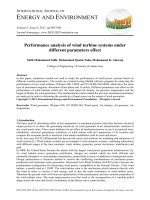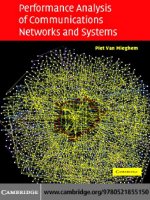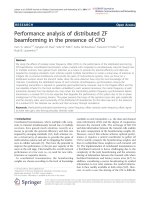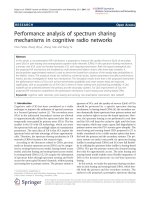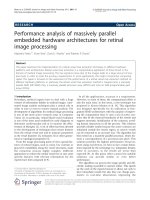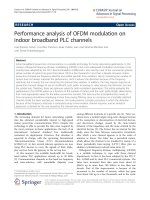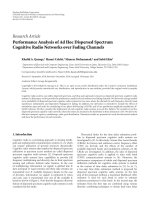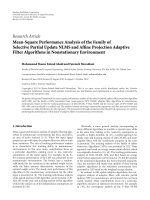Performance analysis of filtering based chaotic synchronization and development of chaotic digital communication schemes
Bạn đang xem bản rút gọn của tài liệu. Xem và tải ngay bản đầy đủ của tài liệu tại đây (6.14 MB, 135 trang )
PERFORMANCE ANALYSIS OF FILTERING BASED
CHAOTIC SYNCHRONIZATION AND
DEVELOPMENT OF CHAOTIC DIGITAL
COMMUNICATION SCHEMES
AJEESH P. KURIAN
(B.Tech, University of Calicut, India)
A THESIS SUBMITTED
FOR THE DEGREE OF DOCTOR OF PHILOSOPHY
DEPARTMENT OF ELECTRICAL AND COMPUTER
ENGINEERING
NATIONAL UNIVERSITY OF SINGAPORE
2006
To my Teachers
Acknowledgements
I would like to thank:
• My advisor Dr. Sadasivan Puthusserypady for his prom pt guidance. Above all for
teaching me the importance of perfection.
• My teachers for showing me how beautiful this world is if I have the quest to learn
and explore; especially Mrs. Santhakumari, Mr. Sathyavan, Prof. N. O. Inasu,
Prof. V. P. Mohandas, Dr. N. Rajanbabu and Dr. S. Sreenadhan.
• My thesis committee members, Prof. C. S. Ng and Dr. George Mathew and thesis
examination panel, Prof. Chor Eng Fong, Prof. Kam Pooi Yu en and Prof. Xu
Jian-Xin for for their valuable comments and suggestions.
• Examiners of this thesis for their ins ightful comments.
• My parents for allow ing me to pursue this study when the circumstances were not
in their favor.
• My friends for helping me to recover from many setbacks; especially Mr. Jayachan-
dran for teaching me the importance of going the extra mile and Mr. Saravanan
for all the helps and motivations.
iii
Papers Originated from this Work
Published/Accepted
1. Ajeesh P. Kur ian, Sadasivan Puthusserypady, and Su Myat Htut, “Perf ormance
enhancement of DS /CDMA system using chaotic complex spreading sequences,”
IEEE Trans. Wireless Commun., vol. 4, pp. 984–989, 2005.
2. Ajeesh P. Kurian and Sadasivan Puthusserypady, “Performance analysis of nonlin-
ear predictive filter based chaotic synchronization,” IEEE Trans. Circuits Sys. –II,
vol. 9, pp. 886–890, 2006.
3. Ajeesh P. Kurian and Sadasivan Puthusserypady, “Chaotic synchronization: A
nonlinear predictive filtering approach,” Chaos, vol. 16, 2006.
4. Ajeesh P. Kurian and Sadasivan Puthusserypady, “Secure digital communication
using chaotic symbolic dynamics,” Invited paper, ELEKTRIK: Turkish J. of Elec.
Eng. & Comp. Sci., (Special issue on Electrical and Computer Engineering Ed-
ucation in the 21
st
Century: Issues, Perspectives and Challenges), vol. 14, pp.
195–207, 2006.
5. Ajeesh P. Kurian and Sadasivan Puthu sserypady, “Unscented Kalman Filter and
Particle Filter for Chaotic Synchronization”, IEEE Asia Pacific Conference on
iv
Papers Originated from this Work v
Circuits and Systems (APCCAS2006), Grand Copthorne Waterfront, Singapore,
December 4–7, 2006
6. Su Myat Htut, Ajeesh P. Kurian, and Sadasivan Puthuss erypady, “A novel DS/SS
system with complex chaotic spreading sequence,” Proceedings of the 57
th
IEEE
Vehicular Technology Conference 2003, Jeju, Korea, April 22−25, 2003, pp. 2090–
2094.
7. Bhaskar T N, Ajeesh P Kurian, and Sadasivan Puthusserypady, “Synchronization of
chaotic maps using predictive filtering techniques,” Proceedings of the International
Conference on Cybernetics and Information Technology, Systems and Applications,
Orlando, USA, July 14–17, 2004.
Submitted/In Preparation
1. Ajeesh P. Kurian and Sadasivan Puthusserypady, “Self synchronizing chaotic stream
ciphers,” IEEE Trans. Circuits Sys. –I: Regular Papers (Submitted).
2. Ajeesh P. Kurian and Sadasivan Puthu s serypady, “Synchron ization of chaotic sys-
tems using unscented Kalman filter and particle filter,” IEEE Trans. Circuits Sys.
–I: Regular Papers (Submitted).
List of Abbreviations
AWGN Additive White Gaussian Noise
BER Bit Error Rate
BPSK Binary Phase Shift Keying
CA Chaotic Attractor
CC Computational Complexity
cdf Cumulative Density Function
CM Chaotic Masking
CDMA Code Division Multiple Access
COOK Chaotic On Off Keying
CSK Chaotic Shift Keying
CSP Constant Summation Property
DCSK Differential Chaotic Shift Keying
DS/SS Direct Sequ en ce Spread Spectrum
EDP Equi-Distributive Property
EKF Extended Kalman Filter
FM-DCSK Frequ en cy Modulated Differential Chaotic Shift Keying
HT Hyperbolic Tangencies
i.i.d Independent and Identically Distributed
vi
List of Abbreviations vii
IM Ikeda Map
LFSR Linear Feedback Shift Register
LLE Local Lyapunov Exponent
MAI Multiple Access I nterference
MC Monte−Carlo
MG Mackey−Glass
MMSE Minimum Mean Square Error
NCA Non-hyperbolic Chaotic Attractor
NISE Normalized Instantaneous Square Error
NMSE Normalized Mean Square Error
NPF Nonlinear Predictive Filter
pdf Probability Density Function
PDMA Parameter Division Multiple Access
PF Particle Filter
PHT Primary Homoclinic Tangencies
PN Pseudo Noise
PWLAM Piece-Wise Linear Affine Map
SD Symbolic Dynamics
SIS Sequ ential Importance Sampling
SNR Signal to Noise Ratio
SS Spread Spectrum
SUT Scaled Unscented Transform
TMSE Total Mean Square Error
TNMSE Total Normalized Mean Square Error
UKF Un scented Kalman Filter
UPF Unscented Particle Filter
UT Unscented Transform
List of Frequently used Symbols
f(.) Smooth nonlinear function (Process function)
h(.) Output function (Measurement function)
E[.] Expectation operation
p(x) Probability den sity function
p(x|y) Conditional probability density function of x given y
∂x
∂y
Partial derivative of x with respect to y
Q(.) Q–function
Exclusive OR (XOR)
J(.) Cost function
diag[.] Diagonal matrix
col[.] Column matrix
ℜ{.} Real part of a complex variable
ℑ{.} Imaginary p art of a complex variable
viii
Summary
The property of sen sitive dependence of chaotic systems/maps on its initial conditions is
being exploited in developing chaotic communication systems. Because of this property,
any ch an ge in control parameters or the initial conditions of the chaotic systems/maps
leads to an entirely different and uncorrelated trajectory. Chaotic communication systems
are developed with the aim of improved security.
In chaotic communication schemes, synchronization of transmitter and receiver chaotic
systems/maps has prime importance. Following the drive−resp on s e synchronization
scheme developed by Pecora and Carrol, researchers from different disciplines have sug-
gested several methods to achieve faster and accurate synchronization. One of the widely
studied metho d for chaotic synchronization is the coupled synchronization. It is shown
that the drive−response system is a special case of the coupled synchr onization. Another
interesting aspect of the coupled synchronization is its similarity with the observer design
problems encountered in nonlinear control systems. In recent literature, many observer
design techniqu es are successfully applied for chaotic synchronization.
Extended Kalman filter (EKF) is a widely studied nonlinear observer for the s y nchro-
nization of chaotic systems/maps. In the presence of the channel noise, its performance
is found to be similar or better than the optimal coupled synchronization. However, it
is observed that the trajectories tend to diverge when EKF is applied to synchronize
ix
Summary x
chaotic maps with non−hyperbolic chaotic attractors (NCA). In Chapter 2, all plausi-
ble divergence behaviours of the EKF based scheme when it is applied to synchr on ize
Ikeda maps (IM) are analyzed in detail. A better understanding of this behaviour is
obtained through the study of homoclinc tangencies, dyn amics of the posterior error
covariance m atrix an d th e local Lyapunov exponents (LLEs) of the receiver IM. The
normalized mean square error (NMSE), total normalized mean square er ror (TNMSE),
and norm alized instantaneous square error (NISE) are used for performance evaluation ,
and are presented in Chapters 2, 3 and 4. The first two performance indices give an
idea about the synchronization error while the latter gives an idea about the speed of
synchr on ization.
To overcome the divergence of the trajectories encountered in the EKF based syn-
chronization, other nonlinear filtering methods such as unscented Kalman filter (UKF),
particle filter (PF) and nonlinear predictive filter (NPF) are proposed and studied. UKF
and PF are sequential Monte−Carlo methods. Using carefully sampled points from the
prior probability, the posterior density is approximated. UKF assumes that the prior den-
sity is Gaussian and uses unscented transform (UT) to approximate the posterior density.
Unlike UKF, the P F does not use the Gaussianity of the prior density. PF can deal with
any probability density and it allows complete representation of the posterior pr ob ability
density of the states. Using the PF, any statistical quantities (such as mean, modes,
kurtosis, and variance) can be computed. In Ch ap ter 3, the performance of the UKF
and PF based methods in synchronizing I M, Lorenz and Mackey−Glass (MG) systems
are discus s ed in detail. Performance of the EKF based scheme is used for comp arison.
NPF uses a very simple predictor corrector model for synchronization. The advan-
tages of the NPF are: (i) the model error is assumed unknown and is estimated as a
part of the solution, (ii) for a continuous system, it uses a continuous model to estimate
the states and hence avoids discrete state jumps, and (iii) there is no need to make
any assu mptions on the pr ior density. In Chapter 4, the performance of the proposed
NPF based scheme is compared to the EKF based scheme. IM, Lorenz and MG systems
are us ed for the numerical evaluation. The condition for stability and an approxim ate
expression for the total normalized mean square error (TNMSE) are also der ived.
Summary xi
Symbolic dynamics (SD) is a coarse−grain representation of the dynamics of chaotic
systems/maps. SD based method are shown to be capable of providing high quality
synchr on ization. In Chapter 5, using the SD based synchronization of 1−D chaotic maps ,
a novel dynamic encoding system is proposed for secure communication. This scheme is
secure and has the self synchronizing properties. A theoretical expression for the upper
bound of the bit error rate (BER) is derived for the new scheme. BER performan ces of
the new scheme is comparable to that of the binary phase shift keying (BPSK) system
at moderate signal to noise ratios (SNRs). The security aspect of the new system is also
analyzed in detail.
Time series generated from chaotic m ap s can be used as spreading codes (sequences)
for the direct sequence/spread spectrum (DS/SS) communication applications. It is an
inexpensive alternative to the linear feedback shift register (LFSR) sequences such as
m-sequences and Gold sequences. In Chapter 6, a novel DS/SS communication system
which exploits the complex nature of the IM is proposed. With this doub le spreading
DS/SS system, the effect of multiple access interference (MAI) is mitigated by choosing
spreading sequences with appropriate cross−correlation properties. The performance of
the system is assessed and demonstrated in multiuser environments by means of computer
simulation with add itive white Gaussian noise (AWGN), Rayleigh fading, and selective
fading channel conditions. Th e proposed system significantly ou tperforms the Gold cod e
DS/SS BPSK system in synchronous channel conditions. In asynchronous case, the
improvement is substantial for low SNR values.
Contents
Acknowledgements iii
Papers Originated from this Work iv
List of Abbreviations vi
List of Frequently used Symbols viii
Summary ix
List of Tables xvi
List of F igures xvii
1 Motivation and Literature Survey 1
1.1 Introduction . . . . . . . . . . . . . . . . . . . . . . . . . . . . . . . . . . . 1
1.2 Characteristics of Chaotic Dynamics . . . . . . . . . . . . . . . . . . . . . 1
1.3 Communication using Chaos . . . . . . . . . . . . . . . . . . . . . . . . . 2
1.4 Chaotic Synchronization . . . . . . . . . . . . . . . . . . . . . . . . . . . . 4
1.4.1 Divergence of EKF in Non−hyperbolic Chaotic Maps . . . . . . . 5
1.4.2 The Unscented Kalman Filter . . . . . . . . . . . . . . . . . . . . . 6
1.4.3 The Particle Filter . . . . . . . . . . . . . . . . . . . . . . . . . . . 6
xii
Contents xiii
1.4.4 The Nonlinear Predictive Filter . . . . . . . . . . . . . . . . . . . . 7
1.5 S ymbolic Dynamics . . . . . . . . . . . . . . . . . . . . . . . . . . . . . . . 7
1.6 Chaos based DS/SS Communication System . . . . . . . . . . . . . . . . . 8
1.7 Major Contributions and Organization of this T hesis . . . . . . . . . . . . 9
2 Extended Kalman Filter for Chaotic Synchronization: Analysis of Di-
vergence Behavior 11
2.1 Introduction . . . . . . . . . . . . . . . . . . . . . . . . . . . . . . . . . . . 11
2.2 S ynchronization of Chaotic System s as a State Estimation Problem . . . . 12
2.2.1 Coupled S y nchronization . . . . . . . . . . . . . . . . . . . . . . . 13
2.3 S tochastic Estimation of States . . . . . . . . . . . . . . . . . . . . . . . . 14
2.3.1 Extended Kalman Filter . . . . . . . . . . . . . . . . . . . . . . . . 15
2.4 Terminology . . . . . . . . . . . . . . . . . . . . . . . . . . . . . . . . . . . 17
2.4.1 Source, Sink and Saddle Fixed Points [2, Chapter 2] . . . . . . . . 17
2.4.2 Stable and Unstable Manifolds [2, C hapter 2] and Homoclinic Tan-
gencies [43] . . . . . . . . . . . . . . . . . . . . . . . . . . . . . . . 17
2.5 Noise Induced Escape from Non−Hyperbolic Chaotic Systems/Maps . . . 18
2.5.1 Primary Homoclinic Tangencies of Ikeda Map . . . . . . . . . . . . 19
2.6 Discussion . . . . . . . . . . . . . . . . . . . . . . . . . . . . . . . . . . . . 19
2.6.1 Case-I: Convergence to a Stable Fixed Point . . . . . . . . . . . . . 19
2.6.2 Case-II: Synchronization with Divergence to a Stable Fixed Point . 21
2.6.3 Case-III: Synchronization with Intermittent Burst of Desynchro-
nization . . . . . . . . . . . . . . . . . . . . . . . . . . . . . . . . . 22
2.6.4 Behaviour of Local Lyapunov Exponents . . . . . . . . . . . . . . . 24
2.7 S ynchronization Ch aracteristics of IM . . . . . . . . . . . . . . . . . . . . 26
2.8 Conclusion . . . . . . . . . . . . . . . . . . . . . . . . . . . . . . . . . . . 26
3 Unscented Kalman Filter and Particle Filter for Chaotic Synchroniza-
tion 29
3.1 Introduction . . . . . . . . . . . . . . . . . . . . . . . . . . . . . . . . . . . 29
3.2 The Unscented Kalman Filter . . . . . . . . . . . . . . . . . . . . . . . . . 30
Contents xiv
3.2.1 Unscented Transform . . . . . . . . . . . . . . . . . . . . . . . . . 30
3.2.2 Scaled UT . . . . . . . . . . . . . . . . . . . . . . . . . . . . . . . . 31
3.2.3 Unscented Kalman Filter . . . . . . . . . . . . . . . . . . . . . . . 33
3.3 Particle Filters . . . . . . . . . . . . . . . . . . . . . . . . . . . . . . . . . 34
3.3.1 Perfect Monte−Carlo Simulation . . . . . . . . . . . . . . . . . . . 35
3.3.2 Importance Sampling . . . . . . . . . . . . . . . . . . . . . . . . . 35
3.3.3 Choice of Proposal Distribution . . . . . . . . . . . . . . . . . . . . 37
3.4 Results and Discussion . . . . . . . . . . . . . . . . . . . . . . . . . . . . . 41
3.4.1 Case–I: IM . . . . . . . . . . . . . . . . . . . . . . . . . . . . . . . 41
3.4.2 Case–II: Lorenz System . . . . . . . . . . . . . . . . . . . . . . . . 44
3.4.3 Case–III: MG System . . . . . . . . . . . . . . . . . . . . . . . . . 48
3.5 Conclusion . . . . . . . . . . . . . . . . . . . . . . . . . . . . . . . . . . . 51
4 Nonlinear Predictive Filter for Chaotic Synchronization 53
4.1 Introduction . . . . . . . . . . . . . . . . . . . . . . . . . . . . . . . . . . . 53
4.2 Nonlinear Predictive Filter . . . . . . . . . . . . . . . . . . . . . . . . . . 54
4.3 S tability Analysis . . . . . . . . . . . . . . . . . . . . . . . . . . . . . . . . 55
4.4 Results and Discussion . . . . . . . . . . . . . . . . . . . . . . . . . . . . . 58
4.4.1 Case–I: IM . . . . . . . . . . . . . . . . . . . . . . . . . . . . . . . 58
4.4.2 Case–II: Lorenz System . . . . . . . . . . . . . . . . . . . . . . . . 62
4.4.3 Case–III: MG System . . . . . . . . . . . . . . . . . . . . . . . . . 64
4.4.4 Parameter Mismatch . . . . . . . . . . . . . . . . . . . . . . . . . . 66
4.4.5 Performance Comparison of EKF, UKF, PF and NPF . . . . . . . 68
4.5 Conclusion . . . . . . . . . . . . . . . . . . . . . . . . . . . . . . . . . . . 69
5 Dynamical Encoding using Symbolic Dynamics 71
5.1 Introduction . . . . . . . . . . . . . . . . . . . . . . . . . . . . . . . . . . . 71
5.2 Chaotic Shift Keying . . . . . . . . . . . . . . . . . . . . . . . . . . . . . . 72
5.3 S ymbolic Dynamics . . . . . . . . . . . . . . . . . . . . . . . . . . . . . . . 74
5.3.1 SD of the Logistic Map . . . . . . . . . . . . . . . . . . . . . . . . 75
5.3.2 Synch ronization using SD . . . . . . . . . . . . . . . . . . . . . . . 75
Contents xv
5.4 Dynamic Encod ing . . . . . . . . . . . . . . . . . . . . . . . . . . . . . . . 77
5.4.1 Theoretical Upper Bound of the BER . . . . . . . . . . . . . . . . 78
5.5 Results and Discussion . . . . . . . . . . . . . . . . . . . . . . . . . . . . . 79
5.5.1 BER An alysis . . . . . . . . . . . . . . . . . . . . . . . . . . . . . . 79
5.5.2 Security Analysis . . . . . . . . . . . . . . . . . . . . . . . . . . . . 82
5.6 Conclusion . . . . . . . . . . . . . . . . . . . . . . . . . . . . . . . . . . . 88
6 Spread Spectrum Communication System using Ikeda Map 89
6.1 Introduction . . . . . . . . . . . . . . . . . . . . . . . . . . . . . . . . . . . 89
6.2 S ystem Mod el . . . . . . . . . . . . . . . . . . . . . . . . . . . . . . . . . . 90
6.2.1 Transmitter . . . . . . . . . . . . . . . . . . . . . . . . . . . . . . . 90
6.2.2 Receiver . . . . . . . . . . . . . . . . . . . . . . . . . . . . . . . . . 92
6.3 S preading Sequence Generation . . . . . . . . . . . . . . . . . . . . . . . . 93
6.3.1 m- Sequences and Gold Sequences . . . . . . . . . . . . . . . . . . 93
6.3.2 Design of Spreading Sequence with Iterated Chaotic Maps . . . . . 94
6.3.3 Spreading C odes from IM . . . . . . . . . . . . . . . . . . . . . . . 94
6.3.4 Optimum Selection of IM based Spreading Sequences . . . . . . . . 94
6.4 Results and Discussion . . . . . . . . . . . . . . . . . . . . . . . . . . . . . 95
6.4.1 Synch ronous System . . . . . . . . . . . . . . . . . . . . . . . . . . 96
6.4.2 Asynchronous System . . . . . . . . . . . . . . . . . . . . . . . . . 96
6.5 Conclusion . . . . . . . . . . . . . . . . . . . . . . . . . . . . . . . . . . . 99
7 Conclusion 101
7.1 Chaotic Synchronization . . . . . . . . . . . . . . . . . . . . . . . . . . . . 102
7.1.1 Performance of the UKF and PF . . . . . . . . . . . . . . . . . . . 102
7.1.2 Performance of NPF . . . . . . . . . . . . . . . . . . . . . . . . . . 103
7.2 Application of SD to Communications . . . . . . . . . . . . . . . . . . . . 104
7.3 IM based DS/SS Communication System . . . . . . . . . . . . . . . . . . 104
7.4 Future Directions . . . . . . . . . . . . . . . . . . . . . . . . . . . . . . . . 105
Bibliography 106
List of Tables
3.1 NMSE of IM . . . . . . . . . . . . . . . . . . . . . . . . . . . . . . . . . . 43
3.2 NMSE of the Lorenz system . . . . . . . . . . . . . . . . . . . . . . . . . . 47
3.3 NMSE of the MG system . . . . . . . . . . . . . . . . . . . . . . . . . . . 50
4.1 NMSE of IM . . . . . . . . . . . . . . . . . . . . . . . . . . . . . . . . . . 62
4.2 NMSE of Lorenz system . . . . . . . . . . . . . . . . . . . . . . . . . . . . 63
4.3 NMSE of MG system for different values of τ (17 and 100) . . . . . . . . 67
4.4 Performance comparison for IM . . . . . . . . . . . . . . . . . . . . . . . . 68
4.5 Performance comparison for Lorenz system . . . . . . . . . . . . . . . . . 68
4.6 Performance comparison for MG system (τ = 17) . . . . . . . . . . . . . . 68
5.1 S tatistical Test Results . . . . . . . . . . . . . . . . . . . . . . . . . . . . . 84
xvi
List of Figures
2.1 S chematic of the coupled synchronization method. . . . . . . . . . . . . . 13
2.2 S chematic of extended Kalman filter . . . . . . . . . . . . . . . . . . . . . 16
2.3 S table an d unstable manifolds and HT of a fixed point . . . . . . . . . . . 18
2.4 The stable fixed point and CA (blue) of the IM. Basin of attraction for
CA (white) and P1 (green) are also shown. . . . . . . . . . . . . . . . . . 20
2.5 PHTs (yellow) and th e most probable exit path (red+). . . . . . . . . . . 20
2.6 Transmitter and receiver CAs (Case-I). . . . . . . . . . . . . . . . . . . . . 21
2.7 Transmitter and receiver CAs (Case-II). . . . . . . . . . . . . . . . . . . . 22
2.8 Transmitter and receiver CAs (Case-III). . . . . . . . . . . . . . . . . . . . 23
2.9 NIS E performan ce of EKF based synchronization of IMs. . . . . . . . . . 24
2.10 Local Lyapunov exponents: (a) Case-I, (b) Case-II and (c) Case-III. . . . 25
2.11 Transmitter vs receiver states (x
R
and ˆx
R
) after synchronization for EKF
based scheme. . . . . . . . . . . . . . . . . . . . . . . . . . . . . . . . . . 25
2.12 NMSE performance of EKF based scheme. . . . . . . . . . . . . . . . . . 27
2.13 TNMSE performance of EKF based scheme. . . . . . . . . . . . . . . . . 27
3.1 Uns cented transform. . . . . . . . . . . . . . . . . . . . . . . . . . . . . . . 31
3.2 Re−sampling process. . . . . . . . . . . . . . . . . . . . . . . . . . . . . . 38
3.3 S chematic of PF. . . . . . . . . . . . . . . . . . . . . . . . . . . . . . . . . 40
xvii
List of F igures xviii
3.4 Transmitter vs receiver s tates (x
R
and ˆx
R
) after s ynchronization for PF
and UKF based schemes (IM). . . . . . . . . . . . . . . . . . . . . . . . . 42
3.5 Error dynamics of IM for the PF and UKF based schemes. . . . . . . . . 43
3.6 NMSE of IM for the PF, UKF and EKF based schemes. . . . . . . . . . 44
3.7 TNMSE of IM for the PF, UK F and EKF based schemes. . . . . . . . . 44
3.8 Lorenz attractor (σ = 10, r = 28 and c =
8
3
). . . . . . . . . . . . . . . . . 45
3.9 Transmitter vs receiver states (x and ˆx) after synchronization for the PF
and UKF based schemes (Lorenz system). . . . . . . . . . . . . . . . . . 46
3.10 Error dynamics of Lorenz system for UKF and PF based schemes. . . . . 46
3.11 NMSE of state x (Lorenz) for the PF, UKF and EKF based schemes. . . 47
3.12 TNMSE of Loren z system for the PF, UKF and EKF based schemes. . . 48
3.13 MG attractor (b = 0.2, a = 0.1 and τ = 17). . . . . . . . . . . . . . . . . . 49
3.14 Transmitter vs receiver states (x and ˆx) after synchronization for EKF
based scheme (MG system). . . . . . . . . . . . . . . . . . . . . . . . . . 49
3.15 Error dynamics of MG system for the PF and UKF based schemes. . . . . 50
3.16 NMSE MG system for UKF, PF and EKF based schemes. . . . . . . . . 51
4.1 S chematic of the NPF. . . . . . . . . . . . . . . . . . . . . . . . . . . . . . 55
4.2 TMS E for NPF based scheme (Lorenz system: using numerical integration
of Eq.(4.13)). . . . . . . . . . . . . . . . . . . . . . . . . . . . . . . . . . . 58
4.3 Transmitter vs receiver states (x
R
and ˆx
R
) after synchronization for NPF
based scheme (IM). . . . . . . . . . . . . . . . . . . . . . . . . . . . . . . 59
4.4 Error dynamics of IM for NPF and EKF based schemes. . . . . . . . . . 60
4.5 NMSE of state x
R
(IM) for NPF and EKF based schemes. . . . . . . . . . 61
4.6 TNMSE of IM for NPF and EKF based schemes. . . . . . . . . . . . . . . 61
4.7 Transmitter vs receiver states (x and ˆx) after synchronization for NPF
and EKF based schemes (Lorenz s y s tem). . . . . . . . . . . . . . . . . . . 62
4.8 Error dynamics of Lorenz system for NPF and EKF based schemes. . . . 63
4.9 NMSE of state x (Lorenz) for NPF and EKF based schemes. . . . . . . . 64
4.10 TNMSE of Loren z system for NPF and EKF based schemes. . . . . . . . 64
List of F igures xix
4.11 Transmitter vs receiver states (x and ˆx) after synchronization for NPF
and EKF based schemes (MG system). . . . . . . . . . . . . . . . . . . . . 65
4.12 Error dynamics of MG system for the NPF and EKF based schemes. . . . 66
4.13 NMSE of state x (MG system) for NPF and EKF based schemes. . . . . 66
4.14 NMSE of MG system for different values of τ at transmitter for EKF and
NPF based schemes. . . . . . . . . . . . . . . . . . . . . . . . . . . . . . . 67
5.1 Chaotic shift keying scheme. . . . . . . . . . . . . . . . . . . . . . . . . . . 72
5.2 S ate spaces of the skewed tent maps (a = 0.43): (a) s kewed tent map and
(b) inverted skewed tent map. . . . . . . . . . . . . . . . . . . . . . . . . . 73
5.3 Generating partition of the logistic map. . . . . . . . . . . . . . . . . . . . 75
5.4 S ynchronization using SD. . . . . . . . . . . . . . . . . . . . . . . . . . . . 76
5.5 Proposed communication system. . . . . . . . . . . . . . . . . . . . . . . . 78
5.6 Format of the transmission sequence with interleaved initial condition. . . 78
5.7 BER perf ormance for AWGN channel. . . . . . . . . . . . . . . . . . . . . 81
5.8 Theoretical BER curves of BPSK and the proposed method (AWGN chan-
nel). . . . . . . . . . . . . . . . . . . . . . . . . . . . . . . . . . . . . . . . 81
5.9 BER perf ormance for band−limited channel (Channel model-I). . . . . . . 82
5.10 BER p erformance for b and−limited channel (Channel model-II). . . . . . 83
5.11 Parameter mismatch vs BER. . . . . . . . . . . . . . . . . . . . . . . . . . 85
5.12 BER p erformance under parameter mismatch. . . . . . . . . . . . . . . . . 86
5.13 (a) Original image (b) Receiver uses A = 0.8 (c) Receiver uses A = 0.8 +
10
−16
. . . . . . . . . . . . . . . . . . . . . . . . . . . . . . . . . . . . . . . 86
5.14 Schematic of the modified transmitter. . . . . . . . . . . . . . . . . . . . . 87
5.15 Schematic of the modified receiver. . . . . . . . . . . . . . . . . . . . . . . 88
6.1 Transmitter model for the n
th
user in the proposed chaotic communication
system: (a) passband transmitter model, (b) complex spreading. . . . . . 91
6.2 Receiver model for the n
th
user in the proposed chaotic commun ication
system. . . . . . . . . . . . . . . . . . . . . . . . . . . . . . . . . . . . . . 92
6.3 BER curves und er AWGN channel (Synchronous). . . . . . . . . . . . . . 96
List of F igures xx
6.4 BER curves und er AWGN channel (Asynchronous). . . . . . . . . . . . . 97
6.5 BER curves und er R ayleigh fading channel (Asynchronous). . . . . . . . . 98
6.6 BER curves und er s elective fading channel (Asynchronous). . . . . . . . . 98
Chapter 1
Motivation and Literature Survey
1.1 Introduction
Chaotic systems/maps are nonlinear systems which exhibit complex behaviour. In chaotic
systems, the state variables move in a bounded, non−periodic, random−like fashion.
A distinct property of chaotic dynamics is its long-term unpredictability. In systems
which exhibit chaotic dynamics, initial states w hich are very close to each other produce
markedly different trajectories
1
. This is referred to as sensitive dep en dence on initial
conditions [1]-[3]. In chaotic systems/maps, due to the sensitive dependence on initial
conditions, when nearby points are iterated the error is amplified in each iteration re-
sulting in uncorrelated trajectories.
1.2 Characteristics of Chaotic Dynamics
A dynamic system exhibits either one of the following characteristics when it is excited
by an external stimu lus: (i) the system dissipates all its energy and settles down to a
stable point, (ii) it travels through a periodic orbit with time, or (iii) it diverges from
its initial point and becomes unstable eventually. A fourth class is the chaotic b eh aviour
where the dynamics exhibit a deterministic yet random−like behavior [4]. In chaotic
systems, the dynamics travel thr ou gh a non−periodic orbit called a strange attractor.
1
The points through which the system states travel in the state space are called the trajectories.
1
1.3 Communication using Chaos 2
These systems are characterized by three essential pr operties: (i) sensitivity to its initial
conditions, (ii) mixing, and (iii) dens e unstable period ic points [1]. When nearby tr ajec-
tories evolve to result in uncorrelated trajectories, while forming the same attractor, the
dynamical system is said to possess sensitive depend an ce to initial conditions. Mixing
is the property of the states of a dynamic system to move from one point to another
in state space with non−zero measure (i.e. each point in state space is visited with a
non−zero probability) [1]. Every chaotic attractor is formed by a skeleton of unstable
periodic points with different periods. The trajectories generated from chaotic sy s tems
have wide−band characteristics and noise−like appearance [3]. Chaotic dynamics have
found numerous applications in communication, digital water marking etc. [5]. In this
thesis, chaotic systems/maps are studied for their applications in communications.
1.3 Communication using Chaos
Chaotic time series, with their inherent wide−band and random−looking characteristics,
naturally qualify for secure communication applications. A communication scheme is
chaotic if a chaotic signal generator is used in the system to encode, sp read or carry
the information signal [6][7]. These systems exploit the properties of chaotic dynamics
in one way or the other. There are many applications in which chaos can be used in
communication systems. Most widely studied methods are as follows.
i. Chaotic Masking: This scheme uses chaotic time series as wide-band carrier so
that coding and modulation can be accomplished together. In chaotic masking
(CM) [8], the weak information signal is added to a strong chaotic carrier. With
a synchronized chaotic system at the receiver, a local copy of the carrier signal is
generated and it is subtracted from the received signal to retrieve the information.
Here, the random−looking behavior is used to introduce security.
ii. Chaotic Modulat ion: In chaotic modulation, parameters of the chaotic sys-
tem/map at the transmitter are changed according to the information signal and
the resulting chaotic waveform is transmitted. At the receiver, these parameter
changes are tracked using appropriate metho ds and the information is retrieved [9].
1.3 Communication using Chaos 3
iii. Chaotic Shift Keying: In coherent schemes such as chaotic shift keying (CSK)
and chaotic on–off keying (COOK) [10]-[13], digital information is transmitted using
carrier signals generated by two different chaotic systems/maps. In CSK, output
from two chaotic systems/maps are switched according to the transmitted bit (‘0’
or ‘1’). In COOK, only one chaotic system is used to convey the information bits;
chaotic system/map is turned on or turned off according to the information bits.
In both cases, synchronized chaotic systems/maps at the receiver is used to retrieve
the inf ormation bits.
iv. Non−coherent Chaotic Shift Keying: To avoid the need of chaotic synchro-
nization, many non−coherent chaotic communication systems have been developed
(e.g. differential chaotic shift keying (DCSK) [14], frequency modulated DCSK
(FM−DCSK) [15], etc.). Since these schemes are non−coherent, only a portion
of the transmitted signal is used for carrying the information and rest are used to
retrieve the information. Hence, this class of communication schemes does not need
a syn chronized chaotic system at the r eceiver.
v. Symbolic Dynamics: Symbolic representations of contr olled chaotic orbits/ tra-
jectories produced can be used for developing communication schemes. By ma-
nipulating the symbolic dynamics (SD) of chaotic systems
2
/maps in an intelligent
way, the system produces trajectories in which digital information is embedded in
the corresponding SD [16][17]. Using appropriate synchronization techniques at the
receiver, the message can be retrieved.
vi. Direct Sequence Spread Spectrum: Another way of usin g chaotic systems/maps
in communication systems is to generate spreading co des from chaotic systems/maps.
Since chaotic signals are wide−band, non−periodic an d noise−like, chaotic systems
offer an ample choice of spreading codes [18]-[20].
2
For chaotic systems, the SD is obtained through the Poincare return map [16].
1.4 Chaotic Synchronization 4
1.4 Chaotic Synchronization
It is clear from the above discussion that in most of the chaotic communication schemes,
synchr on ization of the transmitter an d the receiver chaotic systems/maps is essential for
reliable/accurate retrieval of information. Indeed, the use of synchronizing chaotic cir-
cuits for communication applications has evolved into an active area of research. Related
works of synchronization dates back to the research carried out by Fujisaka and Yamada
[21] in 1983. Pecora and Carr oll [22] showed that chaotic systems can be synchronized
using the drive−response scheme. They showed that, by splitting the chaotic system into
drive and response systems, chaotic synchronization can be established if all the transver-
sal Lyapunov exponents of the response system are negative. Following this seminal work,
numerous methods have been proposed to synchronize chaotic systems/maps. A detailed
review of the present state of synchronization of chaotic systems/maps is available in
[23].
Among th e various methods reported, coupled synchronization has attracted the most
interest [24]. If proper coupling is introduced between the transmitter and receiver sys-
tems, reliable synchronization can be established. Synchronization behaviours (speed
and accuracy) depend on the coupling strength. Cou pling strength is selected such that
the local and global transversal Lyapunov exponents of the receiver systems become neg-
ative in noisy and noiseless situations, respectively [25]. Due to the similarity of coupled
synchr on ization scheme with the nonlinear observer design problem, there has been lot of
interest in applying nonlinear observer design schemes for th e synchronization of chaotic
systems/maps [26]-[29].
Research results show that intervals of desynchronization bursts can appear in coup led
synchr on ization when noise is present in the system [27]. In [30], this behavior is explained
with the help of the existence of unstable period ic orbits of chaotic systems. In such
situations, an adaptive estimation of coupling strengths would be optimal. In fact, this
idea led to the application of stochastic estimation techniques for synchronization of
chaotic systems. In [31], stochastic control methods ar e applied for the synchronization
of chaotic systems.
1.4 Chaotic Synchronization 5
Extended Kalman filter (EKF) is one of the widely used stochastic estimation schemes
in n onlinear state estimation and trackin g application s [32, Chapter 5]. In EKF, Kalman
filtering [32, Chapter 4] [33][34, Chapter 6] is applied to the linear ized
3
nonlinear function.
The use of EKF in synchronizing Lorenz systems is reported in [35]. Sobiski and Thorp
[36] used the EKF to develop parameter division multiple access (PDMA) communication
scheme. Application of EKF to synchronize chaotic maps is studied in [37]. Analytical
results for 1D and 2D chaotic maps are derived in [38]. However, a major disadvantage
of EKF is the error in function approximation. For highly nonlinear systems, this error
causes the divergence of trajectories leading to the burst of desynchronization behaviour
[39]-[42].
1.4.1 Divergence of EKF in Non−hyperbolic Chaotic Maps
Noise−induced escape from a chaotic attractor (CA) to another co−existing CA or a sta-
ble fixed point is observed in many non−hyperbolic chaotic attractors (NCAs) [43]. In
such systems, small perturbations get amplified near the primary homoclinic tangencies
(PHTs) and it may eventually take the system states from one CA to another CA or
to a fixed point. Homoclinic tangencies (HTs) are points where the stable and unstable
manifolds of an unstable periodic orbit meet tangentially. At these points, the pertur-
bations may get amplified by a factor of 100 to 1000 [43]. The most probable exit path
(i.e. the m ost probable set of points through wh ich trajectories travel from one basin of
attractor to the other) and the mean exit time of such chaotic systems/maps give a mea-
sure of the system’s stability against weak noise perturbations. In Chapter 2, divergence
behaviour of th e EKF based scheme applied to the synchronization of IM is analyzed in
detail. It is found that the trajectories originating from the CA is taken to a stable fixed
point. Since th e EKF uses the first order Taylor series for approximating the nonlinear-
ities, large errors are introduced to systems with higher order nonlinearities. A possible
solution to over come such difficulties is to apply filtering metho ds which introd uce less
approximation errors. Accordin gly, in this thesis, three nonlinear filtering algorithms are
proposed and applied for the synchronization of the chaotic systems/maps, namely, (i)
3
Linearization is done using the first order Taylor series.
